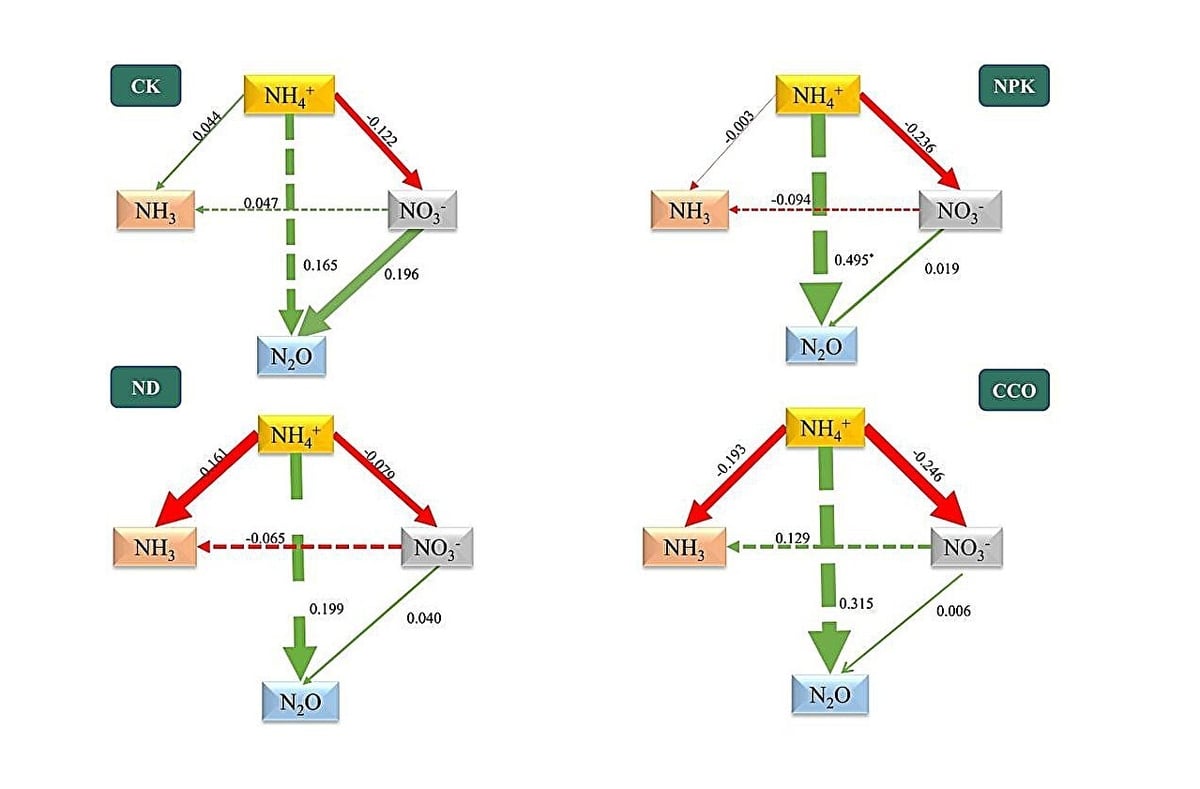June 24, 2025 | 14:31 GMT +7
June 24, 2025 | 14:31 GMT +7
Hotline: 0913.378.918
June 24, 2025 | 14:31 GMT +7
Hotline: 0913.378.918

Path analysis of NH₃, N₂O, NH₄⁺-N, and NO₃⁻-N emissions under different treatments. Credit: Li Yaqun
The study, published in Soil & Tillage Research, represents a major advancement in sustainable agriculture and soil nitrogen management.
The additive, 2-cyclopenten-1-one (CCO), is a plant-derived compound that functions as a dual-action nitrogen inhibitor. It slows the transformation and loss of nitrogen in soil, thereby improving nitrogen use efficiency. Compared to conventional inhibitors such as NBPT (N-butylthiophosphoric triamide) and DMPP (3,4-dimethylpyrazole phosphate), which face persistent challenges including rapid degradation, high production costs, and ecological concerns, CCO offers a greener and potentially more effective alternative.
Fertilizer inhibitors are often described as the "microchips" of stabilized fertilizers due to their role in optimizing nutrient efficiency in a manner similar to how microchips optimize the performance of electronic devices. To evaluate the effectiveness of CCO, the research team conducted field trials and metagenomic sequencing at the National Agro-ecosystem Observation Station in Shenyang, comparing CCO with traditional nitrogen inhibitor (ND) formulations combining NBPT and DMPP.
The results showed that both treatments reduced nitrogen loss and greenhouse gas emissions while increasing crop yields. Specifically, CCO and ND treatments suppressed ammonia (NH₃) volatilization, reduced emissions of nitrous oxide (N₂O) and carbon dioxide (CO₂), and enhanced the soil's methane (CH₄) uptake capacity. However, the two treatments differed significantly in their underlying molecular mechanisms.
Whereas ND treatment primarily modulated the expression of nitrogen-cycling genes such as amoB, nirS, and nisK, CCO treatment exhibited stronger regulatory effects on genes like norB and nirD, which are directly involved in denitrification.
Furthermore, metagenomic analysis revealed that CCO uniquely influenced soil microbial communities and key nitrogen metabolism pathways. Notable changes included shifts in the abundance of microbial genera such as Nocardioides and Nitrospira, as well as alterations in the expression of KEGG pathways like the electron transfer subunit of assimilatory nitrate reductase (K00360) and the NADH-dependent nitrite reductase small subunit (K00363).
This breakthrough not only enriches the portfolio of green inhibitor materials but also represents an important advancement in understanding the microbiological underpinnings of fertilizer efficacy.
According to the researchers, the study strengthens China's international standing in the field of eco-friendly fertilizer technologies and lays a solid foundation for the future development of sustainable, stabilized fertilizers. With agriculture facing mounting pressures to reduce its carbon footprint, innovations like CCO offer vital tools for a greener transition.
(Phys.org)

(VAN) Poultry production in Poland, which has only started recovering from devastating bird flu outbreaks earlier this year, has been hit by a series of outbreaks of Newcastle disease, with the veterinary situation deteriorating rapidly.

(VAN) Extensive licensing requirements raise concerns about intellectual property theft.

(VAN) As of Friday, a salmonella outbreak linked to a California egg producer had sickened at least 79 people. Of the infected people, 21 hospitalizations were reported, U.S. health officials said.

(VAN) With the war ongoing, many Ukrainian farmers and rural farming families face limited access to their land due to mines and lack the financial resources to purchase needed agricultural inputs.

(VAN) Vikas Rambal has quietly built a $5 billion business empire in manufacturing, property and solar, and catapulted onto the Rich List.

(VAN) Available cropland now at less than five percent, according to latest geospatial assessment from FAO and UNOSAT.